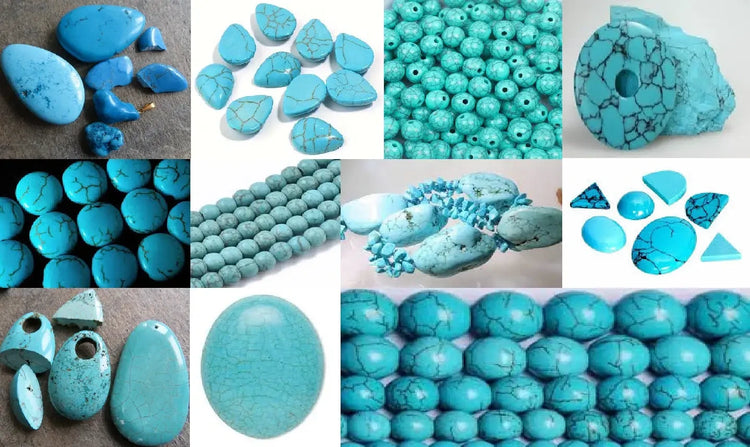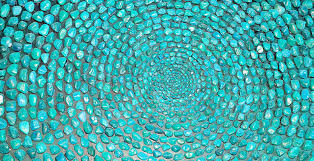Turquoises between true and false
Annex article
Presentation :
https://danslabesaceduptitpoucet.com/collections/turquoise
Name :
- Turquoise.
Etymology:
- Named after Turkey, from where the first turquoises arrived in Europe (Tavernier, 1678).
Group, Family:
- Turquoise Group.
Color :
- Blue, Light Blue, Dark Blue-Green, sometimes Apple Green to Light Green, sometimes Green-Gray to Greenish (Turquoise dehydrated).
Chandelier:
- Resinous, Earthy, (Vitreous on crystals).
Origin :
- Iran, Egypt, China, Tibet, United States, Poland, Brazil, Mexico, Africa etc.
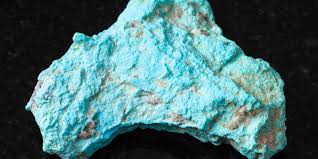
Crystal system:
- Triclinic.
Chemical composition :
- Turquoise: Cu2+Al6(PO4)4(OH)8.4H2O forms a series with Chalcosiderite: Cu2+Fe3+6(PO4)4(OH)8.4H2O | Coloring: Blue: Copper in Cu2+ form in octahedral coordination | Green: Iron in Fe3+ form and Copper in Cu2+ form.
Transparency:
- Very generally Opaque | Sometimes aggregates Translucent | Very rare Transparent crystals.
Density :
- 2.60 to 2.90 (Tur. Iran: 275-2.85; Tur. USA: 2.6-2.7; Tur. China: 2.70; Tur. Israel: 2.56-2.70; Tur. Sinai: 2.81; Tur. Tibet: 2.72; Tur. Brazil: 2.40-2.65) Crystals: 2.84.
Hardness :
- 5 to 6.
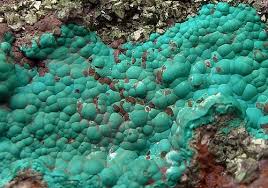
Cleavage:
- Null.
Breakage:
- Conchoidal, Irregular.
Line color:
- White.
Shock resistance:
- Fragile.
Heat resistance:
- Bad (gets dehydrated).
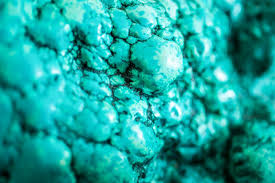
 Special warning about turquoise and the risks of imitations and counterfeits:
Special warning about turquoise and the risks of imitations and counterfeits:
When the gem is crisscrossed with veins or brown, gray or black spots, it is called a “matrix”. The most beautiful stones come from Iran, but we also find them in Afghanistan, Argentina, the United States, Russia, Chile, Australia, Brazil, Indochina, Africa, China and Mexico etc.
Turquoise is usually found in areas where rocks have been modified by the intrusion of rocks under volcanic or thermal influence.
Many variations of turquoise come in shades of blue, green, with matrix colors ranging from blue, to golden brown, to black, and sometimes with gold speckles (sometimes called “crazy gold” or iron pirite).
The bluer it is, the higher the copper content. The greener it is, the higher the zinc content. The veins in the stone are caused by a lack of iron and little vanadium.
Here are some examples of variations:
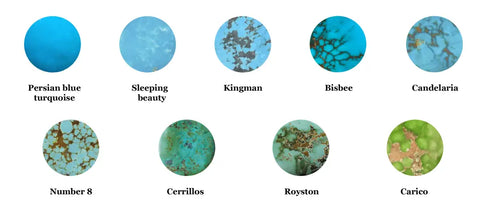
When turquoise is mined, it comes in a range of quality. The quality of a turquoise is determined by its hardness, color and source. High quality turquoise is hard and its colors are vibrant. Lower quality turquoise is soft, chalky and pale in color. Each turquoise mine produces a gradient of quality, with the vast majority of mined turquoise being of low quality. Without treatment, low-grade turquoise is not usable in jewelry because it will crumble when cut, is not durable, and does not hold up well to polishing.
We're not going to lie, beautiful natural turquoise is just as prized and sought after today as it was in the past. In addition, prices having increased considerably in a few years, we find, as with any other prized mineral, rare and expensive, more and more counterfeits and imitations which abound on the market. Before going further on the subject of counterfeiting and possible imitations, we will already start by looking at the three categories of turquoise that it is possible to find today. We will then delve into each of these categories in detail.
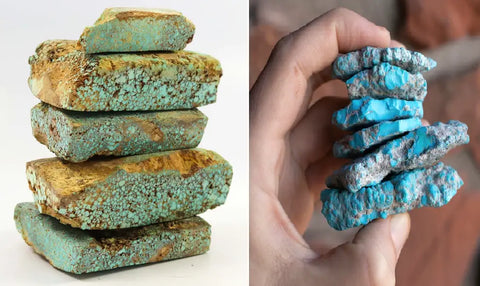
- To begin with we have natural turquoise which can come in different colors and appearance depending on their origins and the elements which compose them.
- We then have stabilized (S) and or treated turquoise and sometimes even both (SD). This is a natural turquoise which, when treated, has undergone recoloring in order to make the color more uniform and which, when stabilized, has undergone the application of a thin layer of resin in order to block the original color because on contact with the acidity of perspiration, it will oxidize and turn green due to its copper content.
- Reconstituted turquoises (ASBL) which are amalgams of turquoise or turquoise powder and very often any powder which only has turquoise in color and which are reconstituted using epoxy resin or other.
- Finally, we have counterfeit or imitated turquoise which are either minerals with almost identical visual characteristics that have been tinted, such as howlite and magnesite, or ceramics, glass or plastic.
To return to the first category of turquoise, I will try to take a first look at the mineral characteristics of this stone and see how to verify its authenticity using its characteristics.
Characteristic natural turquoises and how to verify their authenticity?
Indeed, as you will have seen above in the mineralogical presentation, turquoise is an opaque mineral composed in part of hydrated copper and aluminum phosphate which gives it its pretty bluish color. However, upon oxidation, copper can turn green and similarly upon acidic contact with perspiration, turquoise will take on a color ranging from green to greenish over time. This is also one of the many ways to differentiate a real natural turquoise from a stabilized turquoise or a fake one by the color and its reaction to oxidation. A turquoise that does not react to this will be either fake or stabilized (we will come back to the term stabilized turquoise later).
Turquoise varies greatly in color from blue to dark blue and can be nearly 200 different shades of blue and green, depending on its mineral content. Let's say that in general, the higher the copper content, the more the turquoise will have a "blue" color, while the higher the zinc content, the more the turquoise will have a green color. But blue turquoise can also turn green not due to a change in its composition with a higher intake of zinc, but quite simply upon contact with the acidity of perspiration.
Furthermore, turquoise depending on its variety, its origin and the elements that compose it, can come in different colors ranging from blue to light blue, dark blue-green, sometimes apple green to light green, as well as green-gray to greenish (for Turquoises dehydrated). And come in several different aspects and types of shapes, whether smooth and resinous or even glassy, or sometimes with shapes reminiscent of brains. In extremely rare cases it is also possible to find translucent turquoise crystals, but this is still relatively rare.
It is also possible to calculate the density and hardness of a mineral to verify its authenticity by the following processes:
- To calculate the density:
- To calculate hardness:
For this calculation it is possible to proceed by referring to the value indices mentioned in the table below.
The hardness of a mineral is determined by scratching it with the reference crystals of this scale . Thus, apatite (hardness 5) will scratch minerals softer than it (those whose hardness is less than 5, such as fluorite, calcite, gypsum and talc). The hardness will therefore be between 5 and 6 on the Mohs scale for genuine turquoise.
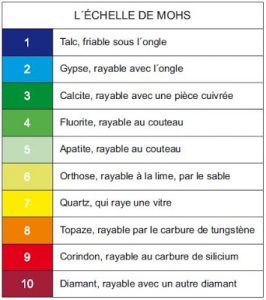
- Other means of control are also possible, such as UV tests, luminescence or refraction tests and many others, but these are only within the reach of laboratories or particularly well-equipped professionals.
- It is also possible with time and practice to spot fake turquoise, by eye and by the weight of it, even if this technique is only really valid on the crudest forms of imitations and counterfeits.
- Or by breaking them to see their true color. Although the techniques have also improved in terms of tint because compared to before when the turquoises were only tinted on the surface, now they can also be tinted to the core, that is to say entirely.
- Real turquoises have natural veins that can be felt on the nail, whereas on fake ones these veins will be stupidly painted as a pale imitation.
Now I will present to you some varieties of natural turquoise starting and going from the most known to the least known.
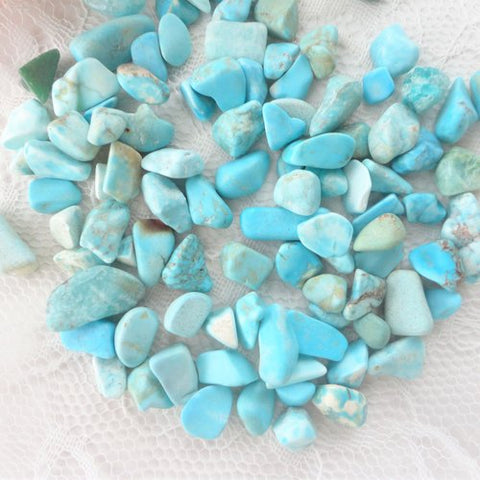

Turquoise from China
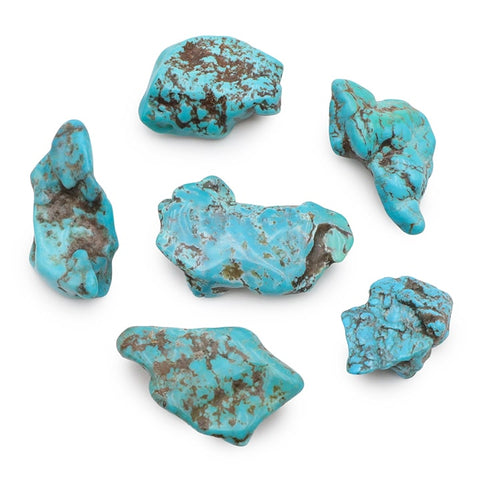
Arizona Turquoise
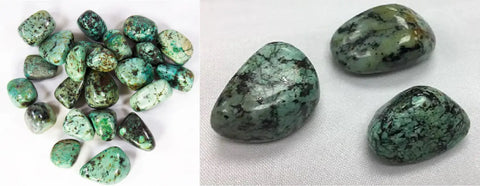
African Turquoise
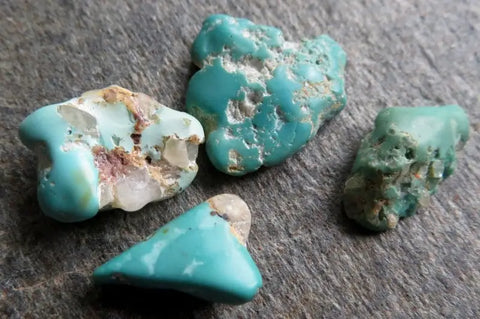
Armenian Turquoise

Turquoise from Mexico
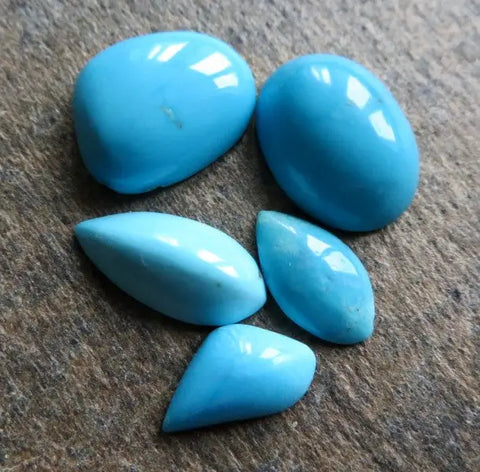
Turquoise " Sleeping Beauty" Arizona Globe mine
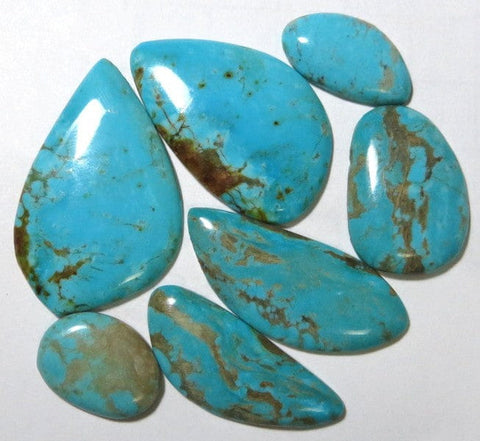
Turquoise “Kingman” Arizona
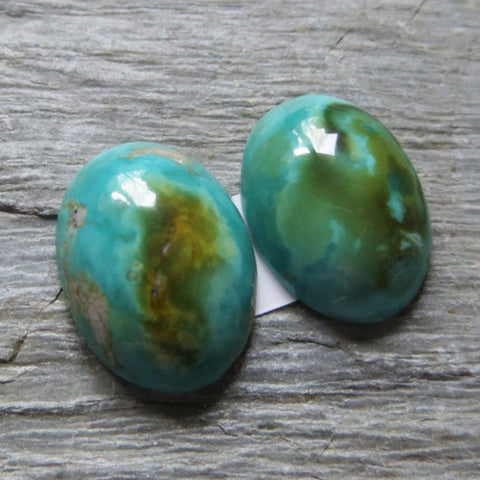
Green Turquoise Fox Mine Nevada
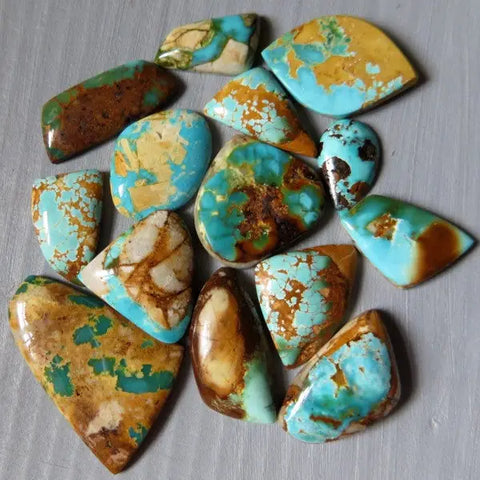
Turquoise on matrix Mountain pilot mine Nevada

Turquoise from Kazakhstan Majkojin
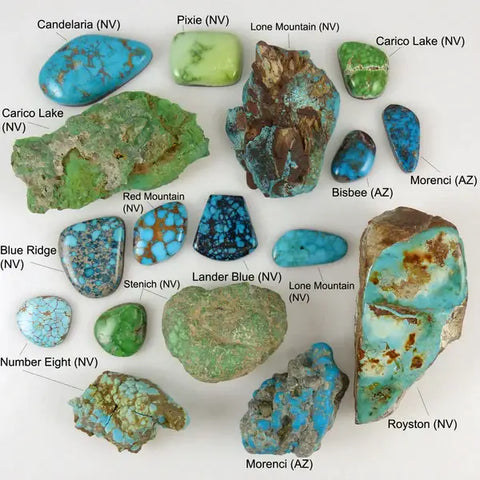
Above, some varieties of American turquoise according to their name and origin. (NV) Nevada (AZ) Arizona
- Kingman Turquoise
- Bisbee Turquoise
Bisbee has earned a reputation as a tall, hard, finely webbed or dendrite blue stone, known for its “chocolate brown” matrix. Bisbee Turquoise also comes in a beautiful dark green color.
- Number 8 Turquoise
This variant was mined in Eureka, Nevada County.
- Cerrillos
- Royston Turquoise
- Carico Lake Turquoise
It takes its name from its mine but above all from the bed of the dry lake in Nevada where this unique stone is extracted. You won't find its green variant anywhere else. The mine still produces but in very small quantities with a wide variety of turquoise colored from dark blue to light green, some with yellow or dark blue "water" webbing.
Prices for Carico grade are higher than most blue turquoise which are available from many mines around the world.
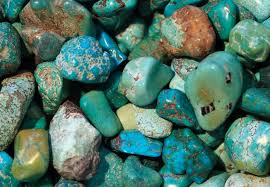
Stabilized, assembled or reconstituted turquoise (S) (SD) (ASBL):
Now we will see together what stabilized turquoise (S) and reconstituted or assembled turquoise (ASBL) are and for this, we will start with stabilized turquoise (S).
What you already need to know is that for reasons of fragility, friability or in relation to the oxidation of colors causing turquoise to change from its beautiful blue color to a greener and often dull color tending towards greenish , a large majority of turquoise on the market is therefore stabilized. A stabilized turquoise is a turquoise that has been covered with a thin layer of resin in order to preserve all of its original appearance as well as its color over time. Sometimes it may even be tinted beforehand to make the color more uniform. In a way, this is still a natural turquoise but it is true that for some purists, the fact that it is stabilized can pose a problem as to the nature of the mineral.

It is important to distinguish that buying stabilized turquoise is not buying a fake stone. Stabilization is a necessary process to make low-grade turquoise hard enough to be shaped. Stabilization is sometimes even useful or even obligatory because without it, working with this fragile and crumbly mineral would be impossible. After processing, stabilized turquoise is harder and is unlikely to break or crack. The stone is no longer porous, so it will not absorb liquids or oils and the color is "locked in", unlike natural turquoise where the color may change or deepen over time.
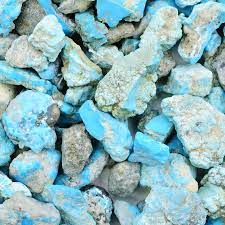
Natural Turquoise from Tibet
When turquoise is mined, the majority is too soft to use in jewelry. This inexpensive, low-grade material must be stabilized before it can be used in jewelry. It is estimated that up to 90% of the turquoise on the market today has been stabilized or enhanced. The lower the quality of natural turquoise, the more processing it needs to become useful for jewelry. And generally speaking, the more the stone has been modified from its natural state, the less valuable it is.
This does not make it a counterfeit brand and in no way constitutes a scam, but it is however recommended, although not obligatory, to specify the fact that the turquoise has been stabilized by applying the letter (S) for stabilized.
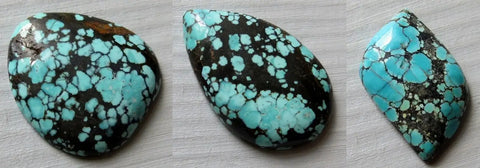
Reconstituted Chinese Turquoise (ASBL) from China
Above, assembled Chinese turquoise. You need a little turquoise color which mixed with epoxy resin will give blue lumps which will in turn be glued together with a black resin imitating rock. Such turquoise, or rather imitation, is perfectly credible to novice eyes. These kinds of imitations generally come from China or India.
Concerning so-called assembled or more often reconstituted turquoises, the problem is quite different and most of the time constitutes a scam and a counterfeit. Indeed, although it is sometimes real turquoise powder re-amalgamated using resin, which no longer really makes it a natural turquoise, most of the time it is just a ordinary powder having absolutely nothing mineral and only having turquoise in color. In this case I would simply say that when in doubt, it is better to abstain than to be fooled. Especially since very often they are still sold at the same price as natural turquoise. In any case, such turquoises must be mentioned under the mention (ASBL) for assembly.
So to summarize this chapter, I would simply say that the treatment by adding resin will be more of an interest for the aesthetic side of the mineral and its durability over time and that even if it is not a quality to be the actual "natural" state does not take away from the fact that it is still true and that it is indeed a natural turquoise. This does not take away anything from its vibrational qualities either.
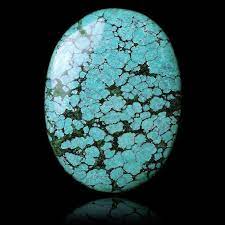
Reconstituted turquoise (ASBL) from China
On the other hand, regarding turquoise, assembled and/or reconstituted because it is only a name to describe the same thing, my advice is not to be fooled into buying this type of thing unless you do so with full knowledge. things.
A final mention is also used by honest merchants which is the mention (SD) and which applies to all natural, dyed and stabilized turquoise. Like the other mentions, this one is not obligatory but guarantees the seriousness and reliability of all traders by using it for the good information of all.
We will now move on to the subject that you are all waiting for, the famous counterfeits. We will therefore see here, thanks to a few photos, the crudest counterfeits and those that are best made, on which even professionals are not safe from being fooled without constant, strict and rigorous control. We will also see, thanks to some explanations and methods already more or less explained above, how to make the difference and distinguish the real ones from the false ones so as to never be fooled again.
Turquoises, imitations and counterfeits distinguish the true from the false:
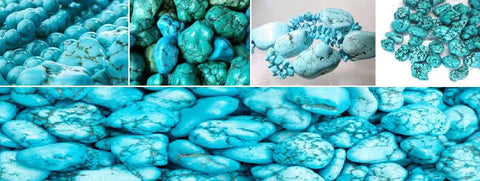
To begin with, what you need to know is that several different processes are used for commercially dishonest purposes to sell dyed minerals or other inexpensive materials imitating turquoise, at the considerably higher price of real, natural turquoise. One of the most well-known processes consists of tinting Howlite which has veins which can remind a little of Turquoise or even tinting Magnesite which can have this slightly rough and knobby appearance resembling a brain, which we find in the visual characteristics of Turquoise. In this case, Howlite and Magnesite will be tinted with a blue identical to Turquoise and often even with Turquoise pigments.

Blue tinted howlite
The same Turquoise blue tinted Howlite also sold under the name Turkenite (Turkenite which can also be tinted Magnesite because in the field of counterfeiting any material can do the trick) which clearly proves the dishonest side of the seller that to sell the same mineral tinted in the same way as Turquoise on one side and as Turkenite on the other.

Howlite tinted on the left / Magnesite tinted on the right
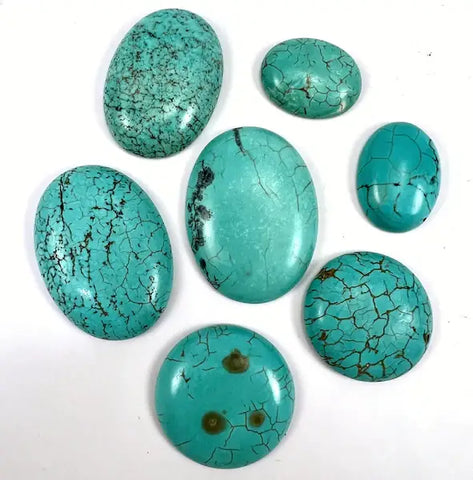
Turquoise block made of polymer clay with acrylic paint baked and polished.
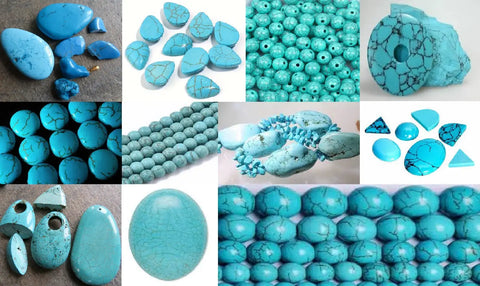
Different imitations of turquoise in resin, plastic or porcelain
As you will have seen, the bases are diverse and varied when it comes to imitation turquoise. Whether on a mineral base with Howlite or Magnesite or even synthetic bases such as resin, plastic, cooked clay or porcelain, nothing stops counterfeiters and the techniques, although very crude for some, are very successful for others.
We will now, without further delay, see together the various means, techniques and processes for verifying and authenticating turquoise.

To begin we can do a test by immersing the mineral in water initially for a few days and then in acetone for a few hours. Dirty dyed turquoise will bleed its color in water and acetone. Acetone will have the effect on assembled or reconstituted Turquoise, not only of discoloring the tinted stone but also of dissolving the black binder which serves to amalgamate the material into a single threshold. Obviously no natural mineral likes to be immersed in acetone but only tinted, assembled and reconstituted minerals will move in acetone.
We can also do a density and hardness test to see if within a reasonable range, the values coincide or not. see the Mohs scale table above for the hardness test and the formula for calculating density.
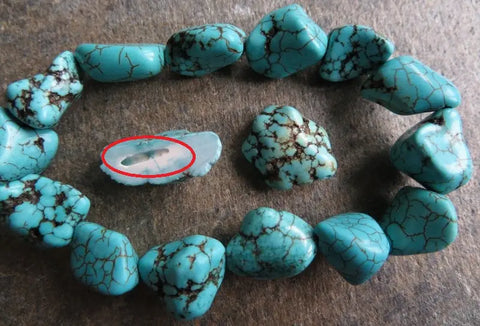
Faux turquoise on resin or plastic base
We can also break the mineral to observe its color at its core, that is to say in its center. For example in the photo above, we can easily see the white color which undoubtedly demonstrates that this material has been tinted to give it the appearance of real turquoise and thus mislead as to its real authenticity.
For resin and plastic imitations, just like amber, we can heat the tip of a needle and point it at the mineral being tested to see if a suspicious smell of resin or plastic is emanating from it or not. Natural turquoise will not give off any suspicious odors since it is a mineral.
As for the change in color upon oxidation, this can only be conclusive if the turquoise is natural and not stabilized because if it is stabilized it will not change color but will not be any less natural for that.
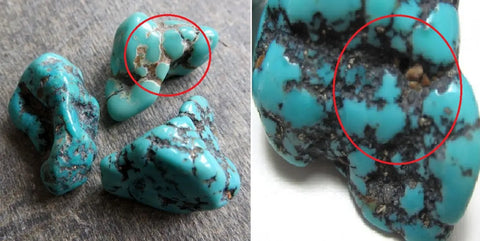
For the photo above we can observe the difference in depth and marking of the crevices. By zooming in on the image we can even distinguish mineral residues caught in the material. That being said, as I have already told you, counterfeiting techniques are becoming more and more clean and undetectable and this kind of detail is nowadays easy to reproduce to further deceive novices and experts alike.
On this last shot below and we will end there, you can see the difference again in the marking of the veins or crevices and the rest of what it would seem to be like a kind of synthetic coloring having overflowed. This can be better seen in the zoomed image. Moreover, the vein roughness test, as mentioned above, can easily be carried out with a nail. If it is marked but cannot be felt with your fingernail, it is then a sign of imitation and therefore obvious counterfeiting.
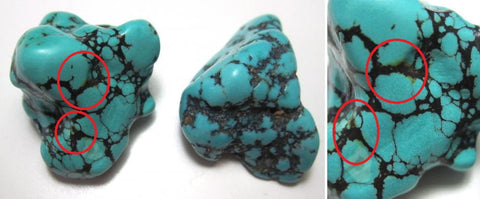
I think that we have now covered the issue on this vast thorny subject which concerns the numerous counterfeits sold on the market and I think that it will now be easier for you to tell the difference in order to no longer be fooled. by unscrupulous merchants.
If you liked this article, I invite you to share it and if you have any questions, I invite you to ask them in the comments of this article and we will answer them with great pleasure.
